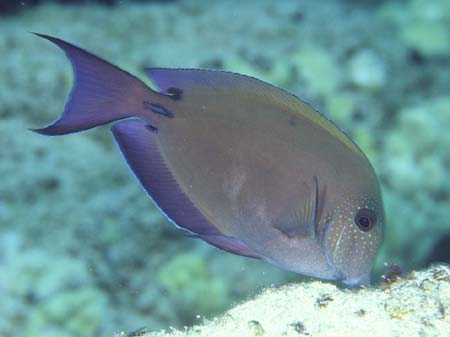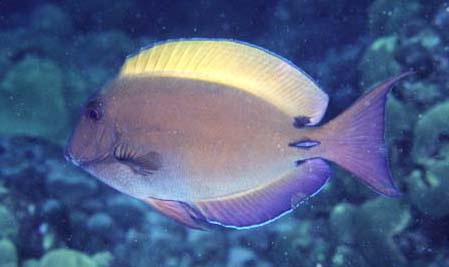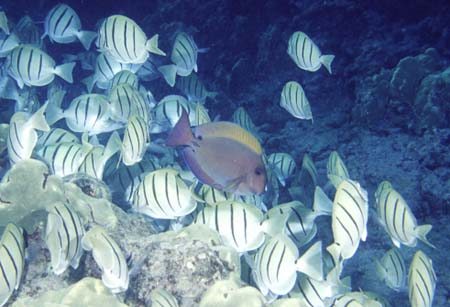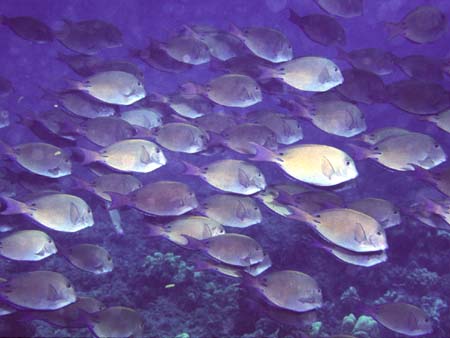| hawaiisfishes.com |
|
Home |
Fishes | Invertebrates |
Books | CDs
| Links |
Contact |
|
past
fishes of the month another
common, drab, seldom-noticed reef fish that might be more interesting
than you thought |
 |
|
BROWN SURGEONFISH ·
ma`i`i`i |
 Brown Surgeonfish displaying aggression |
| Feeding
behavior and ecology The feeding behavior and ecology of the Brown Surgeonfish vary greatly according to local conditions. Along the gently shelving south shore of Kealakekua Bay, Hawai`i, for example, Brown Surgeons are territorial. Here individual fish are commonly seen defending their feeding areas against other herbivores, primarily Convict Tangs. Along the steep dropoff of the Bay’s north shore, however, Brown Surgeons display little territoriality. Here they migrate considerable distances to feed, and often graze peacefully in schools—sometimes with Convict Tangs! (On O`ahu, similar behavioral differences between the two species can be seen respectively at gently-sloping Hanauma Bay and the precipitous "Hale`iwa Trench" dropoff at Ali`i Beach Park.) Dr George Barlow, who studied the intereactions of Brown Surgeonfish and Convict Tangs at Kealakekua in the 1970s, found that in areas where Browns were least numerous, Convicts were able to feed singly, even though attacked about once a minute. Where Browns were moderately common, however, Convicts could feed only by swamping the defenders in dense schools. Finally, where Browns were abundant, Convict Tangs could not feed at all and were absent. |
 Territorial Brown Surgeonfish attempting to drive off a feeding school of Convict Tangs. Hanauma Bay, O`ahu. |
 Non-territorial Brown Surgeonfish schooling to feed. Makaha, O`ahu. |
| Reproduction Like many other surgeonfishes, Brown Surgeons engage in spectacular mass spawning events that are a lot of fun to watch if you happen to be in the right place at the right time. These seem to occur almost daily, from approximately February to early September. More study is needed to determine if the times are tide-related in Hawai`i. Dr. Linn Montgomery, who studied Brown Surgeons in the Red Sea, reports that these fish migrate in single file from various parts of the reef to the "traditional" spawning site, arriving from distances of up to half a mile. Here hundreds, sometimes thousands of fish mill in a dome-shaped aggregation that pulses and swells with activity. Every few minutes a dozen or so excited fish break away, dash upward, spawn, then return to the safety of the school below. Clouds of white gametes released at the apex of their rush resemble fireworks or bursts of flack. In Hawai`i, look for this spectacle in the late afternoon, although it sometimes occurs as early as 10 am. The easiest place to see it on O`ahu is right over the hot water outfall at Kahe Point Beach Park. Another site is along the top of the dropoff at Ali`i Beach Park (the “Hale`iwa Trench”). A constant stream of fish moving in single file along the reef flat is a good sign it’s about to happen—or else has just happened. |
|
Giant
bacteria |
|
Home | Fishes | Invertebrates | Books | CDs | Links | Contact Text and photos copyright John P. Hoover |